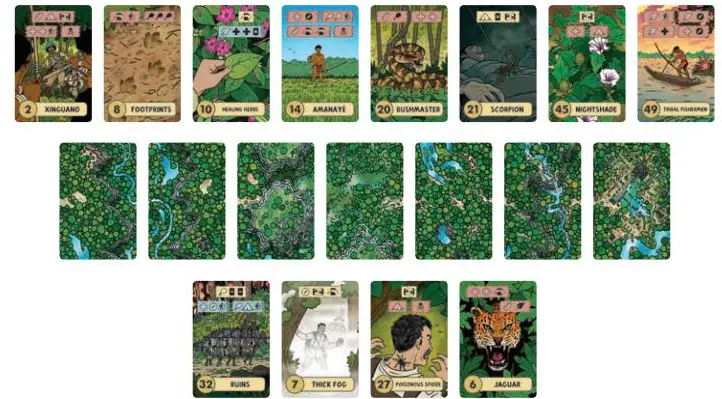
In this version two players will compete to be the first to get their team of explorers to the lost city. To win, you will need to beat the other player in a race to the city, or to survive longest. These rules are broadly similar to the cooperative version, and those rules should be read first.
Setup
Before you set the game up, quickly run through the deck of adventure cards and remove any card with an exclamation mark in the title. There are six of these cards: 1, 8, 17, 33, 41, and 52. Set up two team areas, and choose a pawn each. Each player should take one explorer of each Expertise, three Ammunition tokens and three Food tokens for their team area. Place four Health tokens on each explorer.
Lay out seven expedition cards in the centre of the table, ending in the lost city, and place both pawns on the first expedition card. Shuffle the adventure cards and deal six to each player. Flip the leader token to decide who will be the first expedition leader.

Two Paths
Each round takes the same format of Morning and Evening, and ends the same way.
However, for both Morning and Evening each player has a choice of two paths to add cards to: one path above the row of expedition cards, and one path below it. There is no limit to how many or how few cards can be added to each path. Each player will take one of the two paths, but they do not yet know which.
The leader always plays first. In the Morning they will play one card to begin the first path. The other player will then either add a card to the same path, or begin the second path. Play then alternates, adding one card at a time to either path.
Once three cards each have been added, and the cards have been rearranged, the leader has a decision to make. The leader can either choose which path they want to take now, or allow the other player to choose a path. Regardless of which player chooses a path now, the opposite player will choose which path to take in the Evening.
This means that the player who will choose a path should want the two options to be as uneven as possible in terms of the mix of positive and negative cards, while the other player will want to make the two paths as even as possible. Whichever player chooses a path goes through their cards first, and waits for the other player to complete the other path before moving on. When the round ends each player draws six cards from the deck, and the leader passes the expedition leader token to the other player.

The leader can choose which of the two paths to take, or can allow the other player to make the decision for now.
End of the Game
The game ends in three possible ways:
IF a pawn reaches the final expedition card.
IF all three explorers from a single team are dead.
IF the adventure deck runs out cards for a second time.
If a player ends the game, the other player should complete the path they are currently on, until they reach a game end condition or the path is complete. If the end is triggered by loss of Food at the end of Morning or Evening, the game immediately ends.
Ending 1 - if one player reaches the lost city, they win. If both players reach the lost city in the same Morning or Evening, the player with the most surviving explorers wins. If this is a tie, the player with more cards left in their current path wins. If there's still a tie, the player who started as leader loses.
Ending 2 - if all of one player's explorers die, that player loses. If all six explorers are dead by the end of the same Morning or Evening, the player closest to the lost city is the winner. If this is a tie, the player who started as leader loses.
Ending 3 - if the adventure deck runs out a second time, the player closest to the lost city is the winner. If this is a tie, the player with the most surviving explorers wins. If there's still a tie, the player who started as leader loses.
Continue Reading
